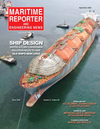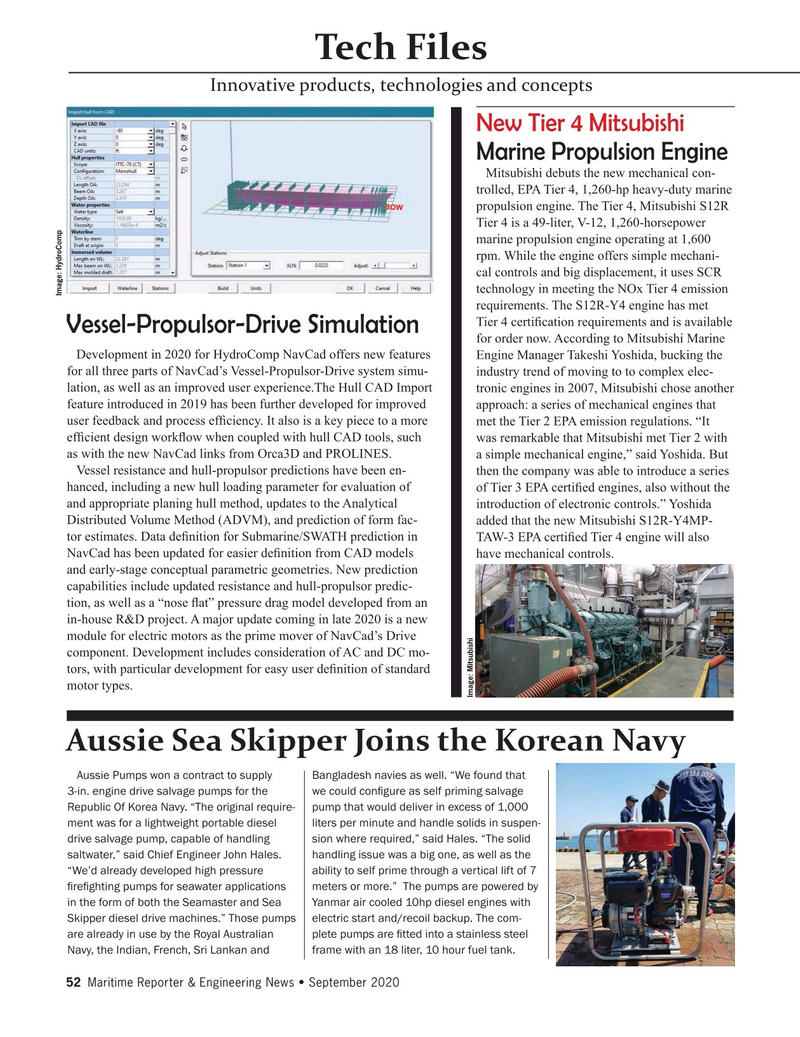
Page 52: of Maritime Reporter Magazine (September 2020)
Marine Design Annual
Read this page in Pdf, Flash or Html5 edition of September 2020 Maritime Reporter Magazine
Tech Files
Innovative products, technologies and concepts
New Tier 4 Mitsubishi
Marine Propulsion Engine
Mitsubishi debuts the new mechanical con- trolled, EPA Tier 4, 1,260-hp heavy-duty marine propulsion engine. The Tier 4, Mitsubishi S12R
Tier 4 is a 49-liter, V-12, 1,260-horsepower marine propulsion engine operating at 1,600 rpm. While the engine offers simple mechani- cal controls and big displacement, it uses SCR technology in meeting the NOx Tier 4 emission
Image: HydroComp requirements. The S12R-Y4 engine has met
Tier 4 certi? cation requirements and is available
Vessel-Propulsor-Drive Simulation for order now. According to Mitsubishi Marine
Development in 2020 for HydroComp NavCad offers new features Engine Manager Takeshi Yoshida, bucking the for all three parts of NavCad’s Vessel-Propulsor-Drive system simu- industry trend of moving to to complex elec- lation, as well as an improved user experience.The Hull CAD Import tronic engines in 2007, Mitsubishi chose another feature introduced in 2019 has been further developed for improved approach: a series of mechanical engines that user feedback and process ef? ciency. It also is a key piece to a more met the Tier 2 EPA emission regulations. “It ef? cient design work? ow when coupled with hull CAD tools, such was remarkable that Mitsubishi met Tier 2 with as with the new NavCad links from Orca3D and PROLINES. a simple mechanical engine,” said Yoshida. But
Vessel resistance and hull-propulsor predictions have been en- then the company was able to introduce a series hanced, including a new hull loading parameter for evaluation of of Tier 3 EPA certi? ed engines, also without the and appropriate planing hull method, updates to the Analytical introduction of electronic controls.” Yoshida
Distributed Volume Method (ADVM), and prediction of form fac- added that the new Mitsubishi S12R-Y4MP- tor estimates. Data de? nition for Submarine/SWATH prediction in TAW-3 EPA certi? ed Tier 4 engine will also
NavCad has been updated for easier de? nition from CAD models have mechanical controls.
and early-stage conceptual parametric geometries. New prediction capabilities include updated resistance and hull-propulsor predic- tion, as well as a “nose ? at” pressure drag model developed from an in-house R&D project. A major update coming in late 2020 is a new module for electric motors as the prime mover of NavCad’s Drive component. Development includes consideration of AC and DC mo- tors, with particular development for easy user de? nition of standard motor types.
Image: Mitsubishi
Aussie Sea Skipper Joins the Korean Navy
Aussie Pumps won a contract to supply Bangladesh navies as well. “We found that 3-in. engine drive salvage pumps for the we could con? gure as self priming salvage
Republic Of Korea Navy. “The original require- pump that would deliver in excess of 1,000 ment was for a lightweight portable diesel liters per minute and handle solids in suspen- drive salvage pump, capable of handling sion where required,” said Hales. “The solid saltwater,” said Chief Engineer John Hales. handling issue was a big one, as well as the “We’d already developed high pressure ability to self prime through a vertical lift of 7 ? re? ghting pumps for seawater applications meters or more.” The pumps are powered by in the form of both the Seamaster and Sea Yanmar air cooled 10hp diesel engines with
Skipper diesel drive machines.” Those pumps electric start and/recoil backup. The com- are already in use by the Royal Australian plete pumps are ? tted into a stainless steel
Navy, the Indian, French, Sri Lankan and frame with an 18 liter, 10 hour fuel tank.
52 Maritime Reporter & Engineering News • September 2020
MR #9 (50-58).indd 52 9/9/2020 10:52:10 AM

 51
51

 53
53
